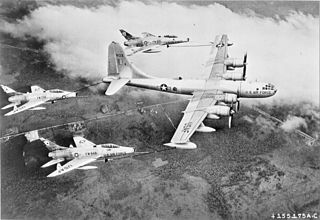
The 70th Intelligence, Surveillance and Reconnaissance Wing is a United States Air Force unit assigned to the 16th Air Force. It is stationed at Fort George G. Meade, Maryland.

The 460th Wing is an inactive wing of the United States Air Force. The 460th Space Wing was activated on 1 October 2001, replacing the 821st Space Group. It was inactivated on 24 July 2020 and replaced by the Buckley Garrison.

The 58th Air Division is an inactive United States Air Force unit. Its last assignment was with Air Defense Command, based at Wright Patterson Air Force Base, Ohio. It was inactivated on 1 February 1959.

The 444th Air Expeditionary Wing is a provisional unit of the United States Air Force assigned to Air Combat Command to activate or inactivate as needed. It was last activated in 2003.

The United States Air Force's 9th Combat Operations Squadron is an Air Force Reserve Command space operations unit located at Vandenberg Space Force Base, California. The 9th augments the 614th Air and Space Operations Center in operating the Joint Space Operations Center, performing combat operations, plans, strategy and intelligence assessments that enable the Commander, Joint Functional Component Command for Space to command and control space forces by providing worldwide space effects and theater support to combatant commanders.

The 358th Fighter Squadron is part of the 495th Fighter Group at Whiteman Air Force Base, Missouri. The squadron was reactivated there in 2015. The squadron was formerly part of the 355th Operations Group at Davis–Monthan Air Force Base, Arizona, operating the Fairchild Republic A-10 Thunderbolt II aircraft conducting close air support missions, until its 2014 inactivation.

The 512th Rescue Squadron is part of the 58th Special Operations Wing based at Kirtland Air Force Base, New Mexico. It formerly operated the Bell UH-1N Twin Huey and currently operates the Sikorsky HH-60G Pave Hawk and the new HH-60W Jolly Green II helicopters training aircrew conducting search and rescue missions.

The 344th Air Refueling Squadron is a unit of the US Air Force, part of the 22d Air Refueling Wing of Air Mobility Command at McConnell Air Force Base, Kansas. It operates the Boeing KC-46 Pegasus aircraft conducting aerial refueling missions.

The 307th Operations Group is an Air Reserve Component of the United States Air Force. It is assigned to the 307th Bomb Wing, Air Force Reserve Command, stationed at Barksdale Air Force Base, Louisiana.

The 90th Operations Group is the operational component of the 90th Missile Wing of the United States Air Force. It is stationed at Francis E. Warren Air Force Base, Wyoming, and is assigned to Twentieth Air Force of Air Force Global Strike Command. The group is responsible for maintaining and operating on alert the wing's assigned LGM-30G Minuteman III intercontinental ballistic missiles.

The 513th Electronic Warfare Squadron is a United States Air Force unit assigned to the 350th Spectrum Warfare Group at Eglin Air Force Base, Florida.

The 487th Bombardment Squadron is an inactive United States Air Force unit. It was last assigned to the 340th Bombardment Wing at Whiteman Air Force Base, Missouri, where it was inactivated on 1 September 1963. The squadron was first activated during World War II. After training in the United States, it deployed to the Mediterranean Theater of Operations, where it flew North American B-25 Mitchell medium bombers, primarily on air support and air interdiction missions, earning two Distinguished Unit Citations for its actions. After V-E Day, the squadron returned to the United States, where it was inactivated in November 1945.

The 488th Bombardment Squadron is an inactive United States Air Force unit. It was last assigned to the 340th Bombardment Wing at Whiteman Air Force Base, Missouri, where it was inactivated on 1 September 1963.

The 717th Bombardment Squadron is an inactive United States Air Force unit. It was last assigned to the 4245th Strategic Wing at Sheppard Air Force Base, Texas, where it was inactivated on 1 February 1963.

The 679th Bombardment Squadron is a disbanded unit of the United States Army Air Forces (AAF). It was last assigned to the 444th Bombardment Group at Dudhkundi Airfield, India where it was disbanded on 12 October 1944.

The 677th Bombardment Squadron is a former United States Army Air Forces unit. It was last assigned to the 444th Bombardment Group at Davis-Monthan Field, Arizona.

The 676th Bombardment Squadron is a former unit of the United States Army Air Forces, last assigned to the 444th Bombardment Group at Davis-Monthan Field, Arizona.

The 920th Air Refueling Squadron is an inactive United States Air Force unit. It was last assigned to the 379th Bombardment Wing at Wurtsmith Air Force Base, Michigan where it was inactivated on 30 September 1992.

The 421st Air Refueling Squadron is an inactive United States Air Force unit. It was last assigned to the 41st Air Division at Yokota Air Base, Japan, where it was inactivated on 18 February 1965.

The 622d Expeditionary Air Refueling Squadron is a provisional United States Air Force unit, assigned to United States Air Forces Europe to activate or inactivate as needed. The squadron was first established during World War II as the 22d Photographic Reconnaissance Squadron. It served in the European Theater of Operations, where it earned a Distinguished Unit Citation and a French Croix de Guerre with Palm for its actions in combat.





























